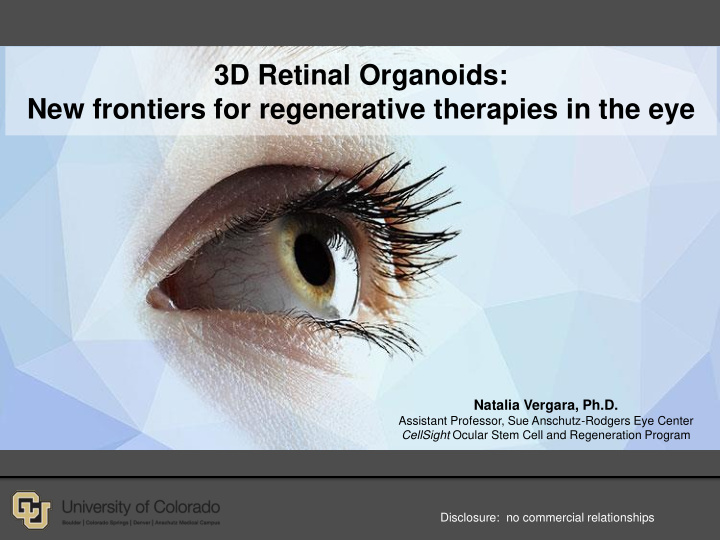



3D Retinal Organoids: New frontiers for regenerative therapies in the eye Harnessing the potential of stem cells Harnessing the potential of stem cells for the treatment of blinding diseases for the treatment of blinding diseases Natalia Vergara, Ph.D. Assistant Professor, Sue Anschutz-Rodgers Eye Center CellSight Ocular Stem Cell and Regeneration Program Disclosure: no commercial relationships
The human retina • Extension of the central nervous system • 7 main types of neurons and glia organized in 3 cell layers • Lacks regenerative capacity
Retinal degenerations lead to vision loss or blindness Normal retina Retinitis pigmentosa Age Related Macular Degeneration Once the retinal neurons die, there’s no treatment available to recover visual function
So what can we do? The promise of iPS cell technologies Induced Pluripotent Stem Cells http://www.nature.com/news/how-ips-cells-changed-the-world-1.20079
The promise of iPS cell technologies Reprogramming Cellular differentiation in 2 dimensions Directed differentiation iPS cells 3D organoids Therapeutic strategy Donor disease modeling, Brain organoid drug screening, cell therapy Kidney organoid
Can we use these cells to make a retina? Zhong et al., Nature Communications 2014
Can we use these cells to make a retina? These 3D retinal “organoids” recapitulate the histological organization and cellular composition of the native retina How do they accomplish this?
Retinal organoids closely mimic the timing and progression of human retinal development D 20-22 D 25-30 D 30-35 D 35 Human Embryo UNSW Embryology RPE domain ef EF Eye NR domain Development Diencephalon Eye field Establishment of Optic Cup formation Retina lamination Steps specification Retinal Domains hiPSC D 12-20 D 16-25 D 25-35 D 35 In space and time…
Initiation of Cell Differentiation neural fate retinal fate DMEM/F12/N2 DMEM/F12/B27 NEAA/hep NEAA hiPSC neural aggregates retinal lineage Meyer et al, 2009
Recapitulation of the developmental processes leading to the formation of the retina in vivo Eye Field domains Retinal domains In vitro VSX2/MITF VSX2 MITF In vivo VSX2 EF NR / RPE Eye Field Specification Specification Optic Cup
Formation of 3D “ mini retinas ”
Formation of 3D retinal organoids HuCD/PH3/DAPI NR NR apical basal RPE RPE
Cells within organoids follow the spatiotemporal pattern of cell differentiation and lamination of the neural retina W13 Ph A G PAX6/OTX2/DAPI BRN3/DAPI AP2 α /PROX1/DAPI W23 AP2 α /REC/DAPI VSX2/MCM2/DAPI CRALBP/DAPI
Cells within organoids follow the spatiotemporal pattern of cell differentiation and lamination of the neural retina
But are these retinal neurons functional? Photoreceptors in retinal organoids are able to respond to light!
Retinal organoids for clinical applications Reprogramming Directed differentiation iPS cells Cell/ tissue transplantation Donor 3D retinal organoids gene-therapy strategies gene replacement gene correctors / potentiators Disease Therapeutic nanodelivery strategies comparative analysis of delivery efficiency modeling strategy cell-type specific targeting toxicology studies drug screening restoration of protein function cell survival / differentiation / maturation
Challenges and opportunities Reprogramming Directed differentiation iPS cells • Improving differentiation/survival Donor 3D retinal organoids Long production time Death of inner neuronal layers at later stages • Improved disease modeling Disease 6 – 60 years vs. 3D retinal organoids 6 – ? Months Lack of NR/RPE apposition • High throughput capability Substantial variability Lack of quantitative assays for 3-dimensional models Lack of automated technologies
3-D automated reporter quantification technology (3D-ARQ) Generation of 3-D retinal organoids Automated sorting and Fluorescence scanning platform handling Expression of transgenic fluorescent Drug treatment reporters or fluorescent staining
3D-ARQ Sensitivity – Reproducibility – Quantitative Power Hoechst EGFP Calcein 10 400 4 S:B ratio S:B ratio S:B ratio 5 200 2 Hoechst: EGFP: Calcein: DNA staining Transgenic Live cell 0 0 0 dye, nuclear protein, labeling dye, cytoplasmic cytoplasmic 1 2 3 4 5 6 7 8 1 2 3 4 5 6 7 8 1 2 3 4 5 6 7 8 YFP DiI BodipyTR 40 1000 10 S:B ratio S:B ratio S:B ratio 20 500 5 DiI: BodipyTR: YFP: Cell Cell Transgenic membrane membrane protein, 0 0 0 labeling dye labeling dye membrane tagged 1 2 3 4 5 6 7 8 1 2 3 4 5 6 7 8 1 2 3 4 5 6 7 8 Fluorescence microplate reader TECAN infinite M1000
3D-ARQ Quantification of transgene expression levels Assessment of developmental processes Assessment of the physiological status and response to drugs Vergara et al., Development 2017
Prominent features of the 3D-ARQ system: • Facilitates quantitative measurements in complex 3-D retinal organoids • Meets HTS assay quality requirements • Versatility of applications as well as fluorophore selection • Ratiometric strategy accounts for size variability • Ability to perform longitudinal studies • Potential for automation • Possibility to perform drug screening in a human 3-D context that mimics the native histoarchitecture and tissue interactions • Potential applicability to other organoid systems
Retinal organoids for clinical applications Reprogramming Directed differentiation iPS cells Cell/ tissue transplantation Donor 3D retinal organoids gene-therapy strategies gene replacement gene correctors / potentiators Disease Therapeutic nanodelivery strategies comparative analysis of delivery efficiency modeling strategy cell-type specific targeting toxicology studies drug screening restoration of protein function cell survival / differentiation / maturation
CellSight Ocular Stem Cell and Regeneration Research Program Catalyzing Stem Cell innovations to save and restore Sight
CellSight 3D Human Retina Modeling Lab (3DRet Lab) hiPSC technology to model retinal degenerative diseases Dr. Val Canto-Soler Ocular Development and Translational Technologies Laboratory Mechanisms of retina development and regeneration & drug screening Dr. Natalia Vergara Laboratory of Developmental Genetics Genetic pathways regulating retinal cell differentiation Dr. Joseph Brzezinski Laboratory of Advanced Ophthalmic Imaging Non-invasive functional imaging Dr. Omid Masihzadeh
CellSight A multidisciplinary team applying a bench-to-bed-side approach Diagnosis Phenotyping / Genotyping Treatment Patient Registry Sue Anschutz- Rodgers Eye patient-specific iPSC clinical product Center Gates CellSight Biomanufacturing Disease Modeling Facility Gene Therapy Screening Quality Control Drug Screening bench cGMP Manufacturing Cell Therapy Strategy product
Acknowledgements Vergara Lab: Anne Vielle Mike Schwanke Davis Aasen Collaborators: NEI Valeria Canto-Soler Miguel Flores-Bellver Silvia Aparicio-Domingo Kang Liu Christian Gutierrez Joe Brzezinski Omid Masizadeh Xiufeng Zhong Jeff Mumm (Johns Hopkins) David Miguez Gomez (UAM) Gail Seigel (University at Buffalo) Special thanks to Linda Barlow
Recommend
More recommend